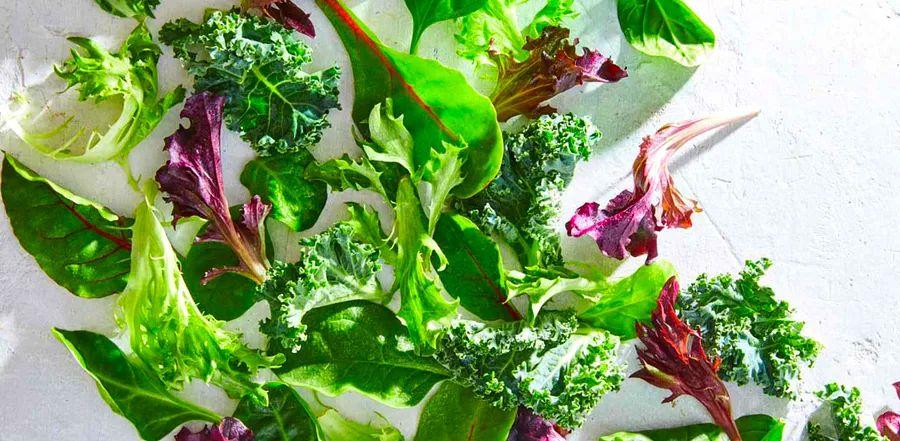Is It Safe to Eat Slimy Salad Greens?

If you enjoy preparing leafy green salads, you might often purchase spring mixes, spinach, lettuce, or arugula in bags or containers. However, these greens don't stay fresh for long, especially when you spot a few slimy leaves. With the history of recalls linked to contaminated leafy greens causing foodborne illnesses, it's understandable to be concerned about what to do with bagged or boxed greens that have gone slimy. We consulted a food scientist to learn the best approach for handling slimy greens, and here's his advice.
Why Do Salad Greens Become Slimy?
Microbes, including bacteria, are naturally present in all types of produce. These microbes accumulate during the growth, harvesting, and processing stages of edible greens.
When exposed to air and moisture, these microbes accelerate the breakdown of the greens, explains Brian Chau, a food scientist and principal at Chau Time, a food consultancy based in San Francisco.
Bagged or boxed leafy greens, such as those separated from lettuce and cabbage, typically last only 3 to 5 days after purchase, compared to whole heads of lettuce or cabbage which can stay fresh for up to two weeks, according to the USDA. Once the package of salad greens is opened, the greens will usually stay fresh for about two days.
What if There Are Just a Few Slimy Leaves in the Container? Can I Pick Them Out?
If only a few leaves are slimy, Chau recommends removing them from the package or container and inspecting the rest for any signs of spoilage such as smell or additional slime. He advises, “If the rest of the greens look fine, you can still use them, as the decay hasn't spread to the others.”
Soaking the greens in vinegar and gently drying them with a paper towel may help reduce bacterial presence, although it won't eliminate bacteria entirely. While this method might give your greens a slightly vinegary taste, it pairs well with a vinaigrette dressing.
If food safety is your top concern, Chau suggests cooking the remaining fresh leaves to kill any lingering bacteria, ensuring they are safe to eat. However, if the majority of the greens are wilting or slimy, it's probably best to discard the whole package and compost it.
Tips for Choosing the Freshest Greens
Buy locally: Locally sourced greens have shorter travel distances, meaning they may stay fresh longer than those that have been shipped from farther away.
Check the expiration date: Choose packages with the furthest expiration date from your purchase time. Be sure to only buy as much as you can consume. Avoid packages that appear damp or contain any slimy or wet leaves—they're best left on the shelf.

Get the recipe: Easy Greek Salad
Talk to produce staff: Staff in the produce section may be able to tell you when they receive their fresh shipments, allowing you to visit on the day the greens are stocked.
Buy whole heads of lettuce and cabbage: While pre-packaged greens are convenient, they often face higher risks of contamination during processing.
Opting for whole heads may be a better choice, particularly if you're concerned about food safety. When you prepare your own salad, you can remove the outer leaves—where contamination tends to be—and enjoy fresh, uncontaminated inner leaves.
Tips for Storing Salad Greens to Keep Them Fresh
The key to keeping your salad greens fresh begins as soon as you leave the grocery store or farmers' market.
Use an insulated cooler bag
Place your salad greens in an insulated cooler bag to help maintain the right temperature, especially on warm days.
Open your bagged or boxed greens once you get home
At home, open the package and spread the leaves on dry paper towels or clean, sanitized towels. Discard any wilted leaves and check for moisture. If any leaves are damp, gently pat them with a paper towel or use a salad spinner to remove excess water.
Store them in an airtight container
Place the leaves back into their original plastic container. For bagged greens, transfer them into a clean, airtight container to reduce humidity. Line both the bottom and top of the container with a folded paper towel to absorb any excess moisture before sealing it.
Make sure to check the container daily to ensure the paper towels stay dry. If they become damp, either consume the greens soon or replace the towels to keep them fresh longer.
Finally, store your greens alongside other quick-wilting produce, such as asparagus, eggplant, fresh herbs, and strawberries, in the fridge's crisper drawer. Setting the crisper drawer to a high humidity setting will limit airflow, helping to extend the shelf life of your produce.

1

2

3

4

5
Evaluation :
5/5